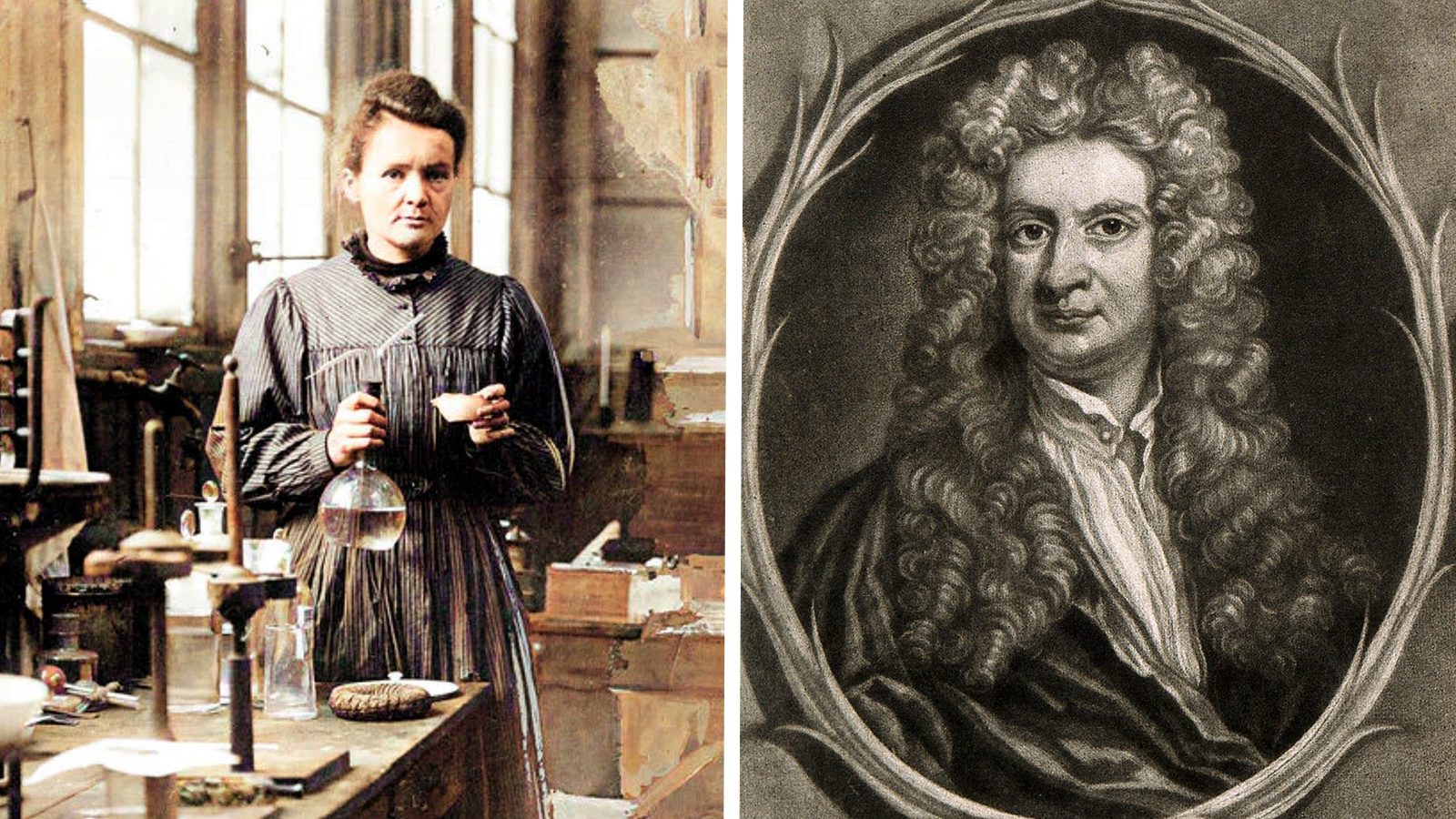These lefties made significant contributions to history, science, and culture.
Have you ever wondered why left-handed people, a trait shared by only 10% of the world’s population, seem so well represented among history’s visionaries, leaders, and artists? Undoubtedly, “lefties” had to struggle to get ahead throughout history.
In ancient times, being left-handed was often viewed with suspicion, sometimes even to the point of open hostility. Some cultures even attempted to “correct” left-handed children, lacking an understanding that hand dominance is meaningless.
Yet, left-handed individuals didn’t just overcome this stigma throughout history. Instead, they soared above it. As a result, they left legacies that changed the very fabric of our world. From the artistic strokes of Leonardo da Vinci’s brush to the resilient leadership of Winston Churchill in the heat of war to the inspiring speeches of activist Malcolm X, left-handed individuals have shaped our civilizations in myriad ways.
Dive with us into the mesmerizing world of these southpaws. It is intriguing to see how they turned what many in the past considered a quirk into a mark of genius.
20 Left-Handed People Who Charted a New Course for Humanity
From the fields of astronomy to the corridors of power, from art studios to the silver screen, these left-handed individuals didn’t just contribute to their respective fields; they revolutionized them. Their profound and varied legacies remind us of the untapped potential within us all, waiting to unleash it.
1. Leonardo da Vinci: The Quintessential Renaissance Man
While many recognize him for his iconic artworks like the Mona Lisa and The Last Supper, Leonardo da Vinci’s influence extended far beyond the canvas.
Born in Vinci, Italy, this left-handed polymath epitomizes the Renaissance spirit. His voracious curiosity led him to explore fields ranging from anatomy to flight. Da Vinci’s notebooks, filled with sketches, inventions, and observations, display an intellect that sought to understand the world. He sketched everything from macroscopic landscapes to the intricate workings of the human body.
His methodologies laid the groundwork for modern scientific illustration. In many ways, da Vinci set a benchmark for interdisciplinary pursuits. He also proved that art and science can intersect and elevate each other to new heights.
2. Marie Curie: Pioneering the Radiant Frontiers
Marie Curie defied norms in an era when men excluded women from scientific pursuits. This left-handed physicist and chemist’s groundbreaking work in radioactivity—a term she coined—shifted scientific paradigms.
She remains the only person to have won Nobel Prizes in physics and chemistry. Her discovery of radium and polonium, her pioneering research on radioactivity, and her development of mobile radiography units during World War I revolutionized medical science and treatment. Curie’s tenacity and brilliance also ushered in new scientific eras. Moreover, many believe she paved the way for women in STEM fields.
3. Sir Isaac Newton: The Architect of Modern Physics
When an apple fell from a tree, it wasn’t just gravity that took shape but the foundations of modern physics. Sir Isaac Newton, the left-handed genius from Woolsthorpe, England, introduced the three laws of motion.
Thus, he fundamentally changed our understanding of the universe. His magnum opus, Mathematical Principles of Natural Philosophy, is one of the most influential works in the history of science.
Furthermore, his work in optics and mathematics, particularly the development of calculus, has underpinned much of the technological and scientific advancements that followed. Newton’s legacy is not just in the theories he crafted but in the methodological rigor and curiosity-driven approach he brought to the scientific process.
4. Jimi Hendrix: Strumming the Strings of Revolution
From the streets of Seattle to the cosmic stage of Woodstock, Jimi Hendrix redefined the boundaries of music with his left-handed strumming. Considered one of the greatest guitarists of all time, Hendrix’s unique style, combining rock, rhythm and blues, and jazz, brought forth sounds previously unimagined.
Tracks like Purple Haze and Voodoo Child were more than just songs. Instead, they were anthems of a generation seeking change. His technique of using amplifier feedback as a musical instrument changed rock music’s soundscape, proving that innovation wasn’t limited to technology but found in the strings of a guitar.
5. Aristotle: The Pillar of Western Thought
Before universities existed, and long before the advent of modern science, there was Aristotle. He was a left-handed philosopher and teacher from Stagira, Greece.
A student of Plato and teacher to Alexander the Great, Aristotle’s influence on Western thought is immeasurable. Venturing into biology, ethics, politics, and metaphysics, he posed questions and methodologies we still explore today.
His approach to syllogistic logic set the foundations for modern scientific methodology, emphasizing empirical observations and logical deductions.
From shaping early Christian thought to influencing scholars, Aristotle’s writings have transcended cultures and epochs, solidifying his role as one of history’s premier intellectuals.
6. Julius Caesar: The Left-Handed Colossus of Rome
When one thinks of empire builders, few can eclipse the shadow cast by Julius Caesar. Born into Rome’s turbulent politics, this left-handed tactician didn’t just navigate the labyrinthine alleys of power; he rewrote the rules.
His military conquests, particularly in Gaul, expanded the Roman Empire’s boundaries and filled its coffers. But his audacious crossing of the Rubicon River, an act of rebellion, changed Roman history.
By ending the Roman Republic and setting the stage for the Empire, Caesar’s life—and dramatic assassination—became pivotal chapters in the annals of history. His legacy also endures in our calendars; the Julian calendar he introduced in 45 BC remained in use for over 1600 years.
7. Babe Ruth: A Southpaw Who Changed the Game
Baseball, America’s pastime, found its greatest icon in George Herman “Babe” Ruth. This left-handed slugger transformed baseball from a low-scoring, strategic game to one where home runs brought fame and fortune.
His larger-than-life personality and prodigious talents at bat made him a household name, influencing countless future athletes. Beyond his 714 career home runs, Ruth’s charisma was pivotal in saving baseball’s reputation after the 1919 World Series cheating scandal. Thus, he proved the importance of character in the world of sports.
Even today, his name is synonymous with greatness, not just in baseball but across all sports.
8. Diego Maradona: The Left-Handed Man Who Dazzled the Soccer World
From the bustling streets of Buenos Aires to the grand stages of World Cup stadiums, Diego Maradona’s journey in football (soccer for Americans!) is the stuff of legends. His early life in the slums did not hint at the stardom that awaited him. Still, Maradona’s talent was undeniable. With a left foot that seemed to have a mind of its own, he controlled the ball in ways that left even seasoned players in awe.
His most iconic moment came during the 1986 World Cup. In a match against England, Maradona scored one of the most memorable goals in football history. Dribbling past multiple defenders, he showcased a breathtaking combination of agility, vision, and skill. This goal, along with his infamous “Hand of God” goal in the exact match, cemented his place as a football icon.
However, Maradona was not just a player. He was a beacon of hope and national pride for Argentina. Maradona’s success was a source of joy and unity in a country that has faced its share of challenges. His passion for the game and raw emotion made him relatable and endeared him to millions.
Off the soccer field, Maradona was equally captivating. His life, filled with highs and lows, mirrored the intensity he displayed on the field. Through controversies, personal struggles, and triumphant comebacks, Maradona remained intrigued until his last days.
His legacy is not just that of an athlete. Instead, he was a man who, with sheer talent and determination, rose above his circumstances to leave an indelible mark on the world of sports. Diego Maradona’s story is a testament to the power of passion, resilience, and the human spirit.
9. Albert Einstein: The Left-Handed Maestro of the Cosmos
In science, few names evoke wonder and admiration like Albert Einstein. With his iconic wild hair and thoughtful gaze, this left-handed physicist radically altered our understanding of the universe.
His theory of relativity challenged established notions of space and time, setting the stage for much of modern physics.
Beyond E=mc^2, Einstein’s contributions span from the photoelectric effect to understanding atomic energy. His research would later pave the way for quantum mechanics.
A pacifist turned advocate for the responsible use of scientific discovery during WWII, Einstein’s legacy is not only as a brilliant scientist but also as a conscientious global citizen.
10. Mahatma Gandhi: This Gentle Left-Handed Person Shook an Empire
Mahatma Gandhi stands out as a unique figure who championed strength through non-violence. With simple clothing and a walking stick, this left-handed leader mobilized millions without raising a sword.
Gandhi’s philosophy of non-violent resistance, or Satyagraha, became instrumental in India’s struggle for independence from British rule.
But his influence did not only touch the Indian subcontinent. Indeed, his ideas inspired others to change history – holllike Martin Luther King Jr. and Nelson Mandela in their quests for justice and equality. Gandhi’s belief in the power of peaceful protest and the potential for change through personal integrity remains a beacon of hope for oppressed communities worldwide.
11. Joan of Arc: The Left-Handed Maiden Who Became a Martyr
In the heart of France’s darkest hours, a left-handed teenager named Joan of Arc rose from obscurity to lead the nation. Guided by her visionary religious experiences, she took up arms. She inspired armies and achieved improbable victories during the Hundred Years’ War.
Her influence was not just military; Joan’s fortitude and unwavering faith restored the confidence of a beleaguered French people. Joan of Arc was eventually captured and tried by the English. After her trial, the British burned her at the stake for unfair accusations of “heresy.” Still, her martyrdom solidified her as a symbol of resistance and faith. The Catholic Church canonized her in 1920. Today, Saint Joan of Arc’s legacy inspires and reminds us to stand up to oppression.
12. Mark Twain (Samuel Clemens): The Left-Handed Bard of the Mississippi
Mark Twain’s influence on American literature is profound. Born Samuel Clemens, this left-handed author’s unique blend of humor, observation, and insight captured the complexities of post-Civil War America.
Twain was not just a novelist. Instead, he was an astute social critic, pointing out societal hypocrisies and injustices with wit and eloquence.
As one of the foremost chroniclers of the American experience, Twain’s works remain an essential exploration of the nation’s soul. Indeed, he challenges readers to confront societal prejudices and injustices.
13. Martina Navratilova: The Left-Handed Queen of the Tennis Court
Across the annals of tennis history, few names resonate as profoundly as Martina Navratilova. This left-handed dynamo dominated tennis in the 1970s and ’80s, garnering 18 Grand Slam singles titles. But her influence extended beyond baseline shots and volleys.
A defector from communist Czechoslovakia, Navratilova became a beacon for political freedom. As one of the first openly gay athletes, she also became an icon in the LGBTQ+ community, championing rights and acceptance.
In combining athletic excellence with social activism, Navratilova’s legacy is not just as a tennis legend. Instead, she became a pioneering advocate for equality and human rights.
14. Ludwig van Beethoven: Harmonies that Reshaped Music
Even in the face of impending deafness, Ludwig van Beethoven’s left-handed brilliance crafted symphonies and sonatas that became the bedrock of classical Music.
This German composer’s works, like the revolutionary Symphony No. 9 or the evocative Moonlight Sonata, transcended the norms of his time. His compositions bridged the Classical and Romantic eras. Thus, he infused music with a passion and intensity previously uncharted.
Beethoven’s resilience in the face of personal challenges, combined with his undeniable musical genius, is an inspiration, proving that art can thrive even amidst adversity.
15. Winston Churchill: The Left-Handed Leader of Great Britain
As the storm clouds of World War II gathered, Winston Churchill emerged as an indomitable force steering Britain through its darkest hour. This left-handed statesman, known for his oratory prowess and strategic insight, galvanized a nation against the looming Nazi threat.
Churchill’s leadership was multifaceted. He organized wartime strategies. He also inspired hope with speeches that still echo today. Post-war, his vision was instrumental in establishing the foundations for modern Europe with initiatives like the ‘Iron Curtain’ speech. Beyond his political achievements, Churchill was also a prolific writer and artist. His multifaceted legacy underscores a single determined individual’s profound impact on history.
16. Charlie Chaplin: The Left-Handed Luminary of Laughter*
In the silent era of cinema, where words were absent and actions spoke volumes, Charlie Chaplin’s comedic genius resonated with audiences globally. With his bowler hat and cane, this left-handed icon created a character, The Tramp. This character captured the complexities and contradictions of the early 20th century.
Through films like “Modern Times” and “The Kid,” Chaplin evoked laughter and poignantly commented on societal issues like industrialization and poverty. As an actor, director, and composer, Chaplin’s influence on cinema is immeasurable, establishing comedy as a medium to entertain and enlighten.
17. Kurt Cobain: The Left-Handed Voice of a Generation
In the grunge-filled streets of Seattle, the raw, unfiltered voice of Kurt Cobain gave rise to Nirvana. Of course, his band defined the ’90s music scene. This left-handed musician’s poignant lyrics and distinctive sound became the anthem for a generation grappling with disillusionment and searching for authenticity.
Tracks like Smells Like Teen Spirit and Come as You Are encapsulated the angst and aspirations of youth. Cobain’s influence transcended music. Additionally, his advocacy for LGBTQ+ rights and gender equality made him a trailblazer in societal issues. Although his life was tragically short, Cobain’s impact on music and culture remains indelible.
18. Malcolm X: The Left-Handed Advocate for Equality
Amidst the civil rights turbulence of the 1960s, Malcolm X emerged as a potent and unapologetic voice for African Americans. His fiery speeches and candid critiques of systemic racism distinguished him from other civil rights leaders in American history.
Born Malcolm Little, his transformation into Malcolm X after joining the Nation of Islam symbolized his rejection of the “slave name” and his embrace of Pan-Africanism. His pilgrimage to Mecca later in life revealed to him the possibility of unity between different races, leading to his evolution in perspective. His autobiography, co-written with Alex Haley, remains a seminal text, providing unparalleled insight into the black experience in America.
A gunman assassinated Malcolm X at the prime of his life, Malcolm X’s legacy continues as a testament to the power of transformation, resilience, and unwavering dedication to justice.
19. Nicolaus Copernicus: The Left-Handed Astronomer Who Moved the Sun
In the heart of the Renaissance, as the world stood on the cusp of a scientific revolution, Nicolaus Copernicus posited a then-heretical idea: the Earth was not the center of the universe. This left-handed astronomer’s heliocentric model, detailed in De revolutionibus orbium coelestium, challenged millennia of Ptolemaic cosmology. While met with resistance initially,
Copernicus’s model paved the way for figures like Kepler and Galileo. That fundamentally alters our understanding of the cosmos. By positioning the sun at the center, Copernicus didn’t just change astronomy; he reshaped humanity’s perspective of its place in the vast expanse of the universe.
20. Pablo Picasso: The Left-Handed Visionary of the Canvas
Pablo Picasso is a colossus in art, where boundaries are continuously pushed and redefined. This left-handed Spaniard had an unmatched knack for innovation. Thus, he co-founded the Cubist movement, redefining traditional forms into abstract, geometric marvels.
Works like Les Demoiselles d’Avignon and Guernica are not just paintings. Indeed, they profoundly reflect on society, war, and the human psyche. From the Blue Period to Surrealism, Picasso’s artistic phases display a restless evolution, constantly pushing, always evolving. His legacy is a testament to the boundless potential of creativity, proving that art isn’t just about portraying reality but reimagining it.
Final Thoughts on the Contributions of Left-Handed People in History
The idea that left-handed people are a quirk of biology diminishes the profound impact that these individuals have had on the world’s history. This eclectic group, drawn from diverse fields, eras, and cultures, showcases that being a ‘southpaw’ isn’t just about which hand one writes with. It’s about perspective, innovation, and often, defying conventional norms.
In a world dominated by right-handedness, these twenty individuals succeeded and thrived, often turning their unique viewpoint into a distinct advantage. Their stories are a testament to the power of individuality. They challenge the notion of conformity, urging us to embrace our peculiarities, for they might be the seeds of genius.
Moreover, in celebrating these left-handed luminaries, we are reminded that progress and innovation often come from the margins, from those who see and experience the world slightly differently.
As we reflect on their achievements, let it serve as a reminder that greatness isn’t determined by which hand you use but by how you choose it. Ultimately, it’s not about left or right; it’s about making a mark that lasts.


















 Community
Community

